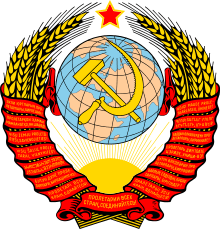Soviet occupation of Manchuria
| Soviet occupation of Manchuria | ||||||||||||||||||||||
| Soviet occupation | ||||||||||||||||||||||
| ||||||||||||||||||||||
|
| ||||||||||||||||||||||
.gif) Soviet gains in North East Asia, August 1945. | ||||||||||||||||||||||
| Capital | Shenyang (Command Station) | |||||||||||||||||||||
| Languages | Chinese (Northeastern Mandarin) Japanese Russian | |||||||||||||||||||||
| Government | Military occupation | |||||||||||||||||||||
| Soviet commander | ||||||||||||||||||||||
| • | 1946 | Rodion Malinovsky | ||||||||||||||||||||
| History | ||||||||||||||||||||||
| • | Soviet troops invaded Manchuria | 9 August 1945 | ||||||||||||||||||||
| • | Withdrawal of all Soviet troops in Manchuria | 3 May 1946 | ||||||||||||||||||||
| ||||||||||||||||||||||
| Today part of | | |||||||||||||||||||||
The Soviet occupation of Manchuria occurred after the Soviet invasion of Manchuria, in the Soviet military occupation of Northeast China (historically also known as Manchuria).
History
On February 11, 1945, the United States, Britain, the Soviet Union three leaders Roosevelt, Churchill and Stalin signed the war against Japan on the Soviet secret agreement "Yalta Agreement" . Hereafter the Soviet Union by the "Yalta Agreement" driven, after Nazi Germany surrendered, actively preparing the war against Empire of Japan.
On August 9, 1945, with the Soviet invasion of the Japanese puppet state of Manchukuo and was the largest campaign of the 1945 Soviet–Japanese War which resumed hostilities between Soviet Union and the Empire of Japan after more than 4 years of peace. Soviets gains on the continent were Manchukuo, Mengjiang (Inner Mongolia) and northern Korean Peninsula. The rapid defeat of Japan's Kwantung Army was a very significant factor in the Japanese surrender and the end of World War II, as Japan realized the Russians were willing and able to take the cost of invasion of its Home Islands, after their rapid conquest of Manchuria and southern Sakhalin.[1][2][3][4][5]
On August 14, 1945, the Nationalist Government and the Soviet Union signed the "Sino-Soviet Treaty of Friendship and Alliance" provisions of the treaty after the war in Manchuria sovereignty to the national government, the Soviets after the Japanese surrender began to retreat within 3 weeks, 3 months withdrawal finished. Later in the withdrawal deadline, the Soviets had twice delayed withdrawal. On February 1946, China's domestic outbreak of a large-scale anti-Soviet campaign. Massive outbreak in China anti-Soviet demonstrations the case, judged the situation after Stalin ordered the Soviet troops from Manchuria homeopathic sudden retreat. On March 10, 1946 night, the Soviet secret withdrawal of Shenyang, then stationed in Manchuria, the Soviets began to evacuate around until May 3, 1946, the Soviets withdraw all of Manchuria.[6]
See also
References
- ↑ "Battlefield - Manchuria - The Forgotten Victory", Battlefield (documentary series), 2001, 98 minutes.
- ↑ Robert Butow, Japan's Decision to Surrender, Stanford University Press, 1954 ISBN 978-0-8047-0460-1.
- ↑ Richard B. Frank, Downfall: The End of the Imperial Japanese Empire, Penguin, 2001 ISBN 978-0-14-100146-3.
- ↑ Robert James Maddox, Hiroshima in History: The Myths of Revisionism, University of Missouri Press, 2007 ISBN 978-0-8262-1732-5.
- ↑ Tsuyoshi Hasegawa, Racing the Enemy: Stalin, Truman, and the Surrender of Japan, Belknap Press, 2006 ISBN 0-674-01693-9.
- ↑ 作者:劉向上 (2009-04-20). "张莘夫事件"与苏军撤出东北 (in Chinese). 揚子晚報網. Retrieved 2009-04-20.
.svg.png)
